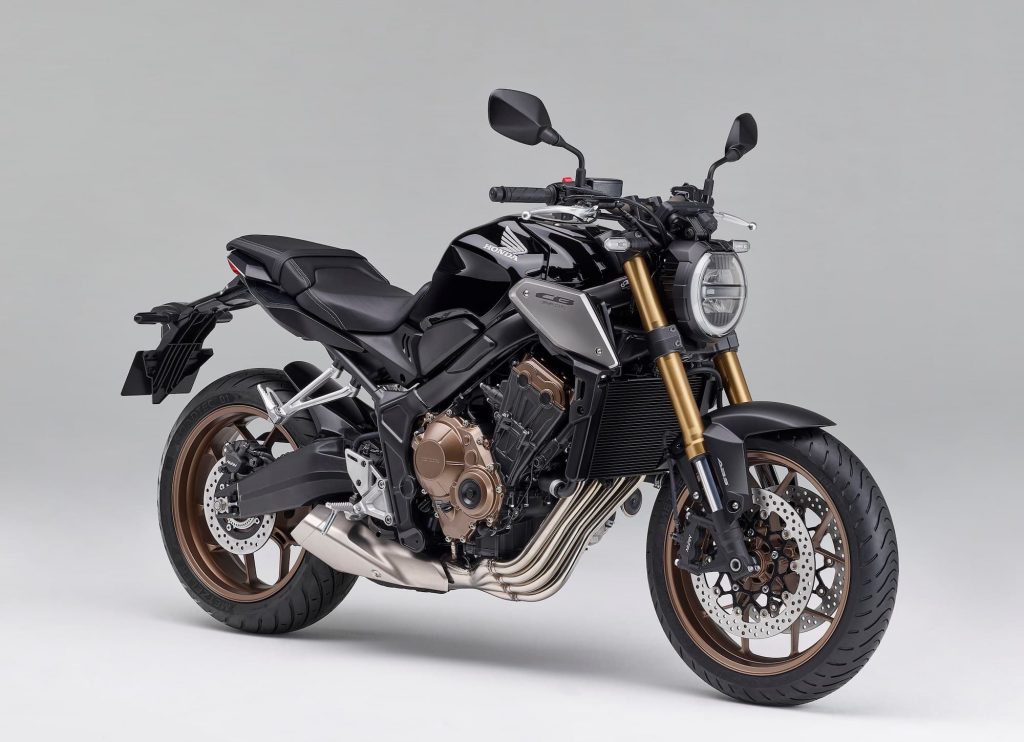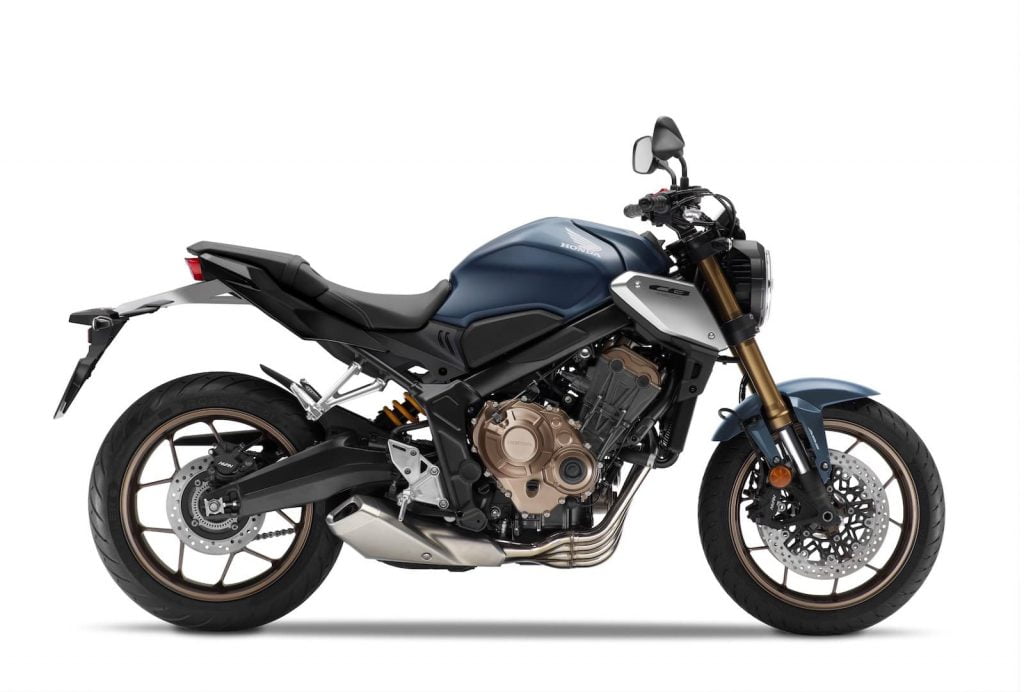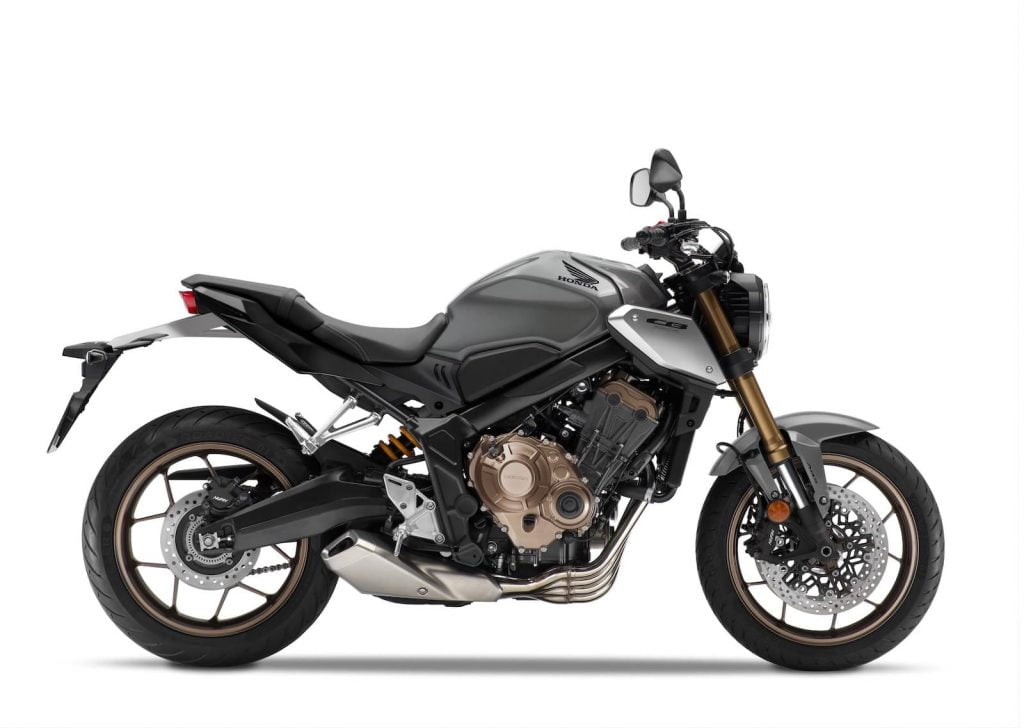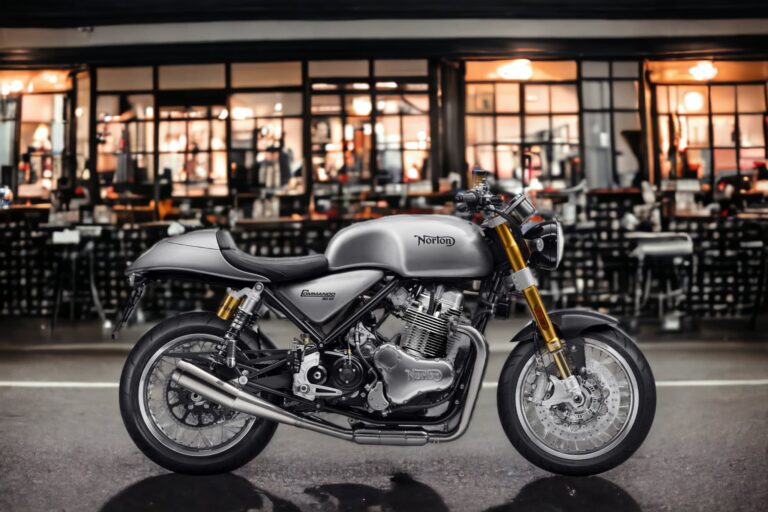Honda CB650R (2019+) Maintenance Schedule and Service Intervals
This is the maintenance schedule and associated service intervals for the Honda CB650R.
This maintenance schedule applies to the Honda CB650R from launch (2019) until today. It’s quite similar to the Honda CBR650R, which has the same underlying internals.
The CB650R is a naked bike comes is a middleweight motorcycle in the “Neo Sports” category, along with the larger CB1000R and the smaller CB300R.
The Honda CB650R isn’t just a reskinned CB650F from which it took over duty. The engine and suspension were also reworked, making altogether a much more compelling motorcycle. It revs higher, and feels a lot tauter.
The CB650R has a 649cc liquid-cooled inline four-cylinder engine that produces 70 kW (95 CV / 94 bhp) at 10000 rpm and 63 Nm (46 ft-lb) of torque at 8500 rpm. It’s paired with a 6-speed manual transmission and a chain final drive. It comes with ABS and traction control (Honda Selectable Torque Control).
In some markets, the Honda CB650R is available in de-tuned format to make it available for learner riders. Don’t fear — the maintenance schedule (and parts needed) for the LAMS or A2-compliant version is the same.
In 2021, Honda updated the CB650R with improved front suspension — Showa Separate Function Big Piston forks, plus a EURO5 compliant engine. Honda made a few small tweaks too, like more forward-set handlebars, an improved dash, and a USB C socket under the seat.
This was originally published 13 Dec 2020, but has since been significantly updated.
This site has links for things like oil and spark plugs from which we earn a commission (which unfortunately nobody can save, not even us). If you appreciate this work, then please use those links. Thanks!
Honda CB650R Service Intervals
Like many Honda motorcycles, the Honda CB650R has 8 000 mile / 12 800 km service intervals. At every service, change the oil and filter, and do a host of checks listed below.
Honda does require an interim service every 4 000 miles / 6 400 km, but only for safety and emissions equipment, e.g. the brakes.
The major valve inspection service interval for the Honda CB650R is every 24 000 miles or 38 400 km — very wide.
Aside from those, make sure you keep the coolant in the CB650R fresh, as well as the brake fluid.
What you need to service the Honda CB650R — Parts and Tools
If you’re servicing your CB650R, aside from general motorcycle maintenance tools, you’ll need a few specific parts.
| Part | Honda CB650R/CBR650R spec |
|---|---|
| Engine oil | Honda recommends SAE 10W-30, JASO T 903 standard MA, like Pro Honda GN4 10W-30, which is very available and affordable. Use a torque wrench to tighten the bolt to 30 Nm (22 lb-ft). |
| Oil filter | Honda’s standard part number for the oil filter is 15410-MFJ-D01 (for many motorcycles). Tighten it to 26 Nm (19 lb-ft). You can also use Hiflofiltro HF204RC (better quality) for the oil filter. |
| Engine coolant | Use Honda Long-life Coolant, which is based on ethylene glycol. |
| Spark Plugs | Use NGK IMR9E-9HES. This is what the manual suggests. Make sure it’s gapped correctly to 0.8-0.9mm (get a gapping tool) and torqued correctly (use a torque wrench). |
| Air filter | Honda OEM part number is 17210-MKN-D50. You can also get the K&N equivalent, HA-6414. |
| Brake fluid | Honda recommends Honda DOT 4. |
| Brake pads | For the front, you need two pairs of brake pads (OEM: 06455-MKN-D51, EBC: FA679HH), and for the rear you need one (OEM: 06435-MGZ-J01, EBC: FA496HH). (Here’s a combined CB650R/CBR650R brake pad change kit.) |
Honda CB650R Maintenance Schedule
Below is the maintenance schedule for the Honda CB650R.
Service intervals for the Honda CB650R are
- A minor service every 4000 mi (6 400 km), involving just inspecting things
- An oil change service every 8000 mi (12 800 km), with more inspections
- A valve inspection service every 24 000 mi (38 400) km. This is a very wide valve service interval.
Honda includes “difficulty levels” of adjustments in the manual. Basically the recommend that you wheels/tires and suspension serviced by a mechanic. But you can do everything else if you’re a competent home mechanic.
Honda also labels changing brake fluid and radiator fluid as requiring “mechanical skill”.
| x 1000 mi | 8 | 16 | 24 | 32 | |
|---|---|---|---|---|---|
| x 1000 km | 12.8 | 25.6 | 38.4 | 51.2 | Every |
| Standard inspection checklist (see below) — Perform all | ✓ | ✓ | ✓ | ✓ | |
| Engine Oil — Replace (Pro Honda GN4) | ✓ | ✓ | ✓ | ✓ | Year |
| Engine Oil Filter — Replace (HF204RC) | ✓ | ✓ | |||
| Air Cleaner — Replace (HA-6414) | ✓ | Service more often if riding in wet/dust. | |||
| Spark Plugs — Inspect | ✓ | ||||
| Spark plugs — Replace | ✓ | ||||
| Valve Clearances — Inspect / adjust | ✓ | ||||
| Radiator Coolant — Replace (Honda Coolant) | 3 Years | ||||
| Brake Fluid — Replace (Honda DOT 4) | 2 years | ||||
| Brake Pads — Check for wear | ✓ | ✓ | ✓ | ✓ | Check between services — 4000 miles / 6400 km |
| Clutch System — Check correct function and free play Target free play: 10-20mm | ✓ | ✓ | ✓ | ✓ | Check between services — 4000 miles / 6400 km |
| Secondary Air Supply System — Inspect | ✓ | ✓ | |||
| Evaporative Emission Control System — Inspect | ✓ | ✓ |
Honda CB650R Standard service checklist
Do the following checks on your Honda CBR650R as part of every scheduled inspection.
| Honda CB650R Inspection Checklist |
|---|
| Fuel Lines — Check condition, correct routing, and for no cracks |
| Throttle operation and free play – Lubricate with Protect all cable life Target free play: 2-6 mm (0.1-0.3 in) |
| Check engine idle speed Target idle speed: 1 250 rpm, +/- 100 rpm |
| Cooling system — Check for no leaks, and that fans come on |
| Drive chain slider — Check wear level. Replace as necessary |
| Brake system — Check for proper function, and free play |
| Brake light switch — Check lights come on |
| Wheels/Tires — Check for dents, tire condition, tread depth |
| Suspension (front and rear) — Check for smooth operation, no leaks |
| Headlight aim — Check, re-adjust after adjusting suspension |
| Side stand / Centre stand — Check for smooth function, lubrication condition |
| Steering head bearings — Check for smooth operation |
| Nuts, bolts, fasteners — Check for presence. Replace / retighten as needed |
| Secondary air supply system — Check |
| Crankcase breather (if fitted) — Check, clean as needed |
Honda CB650R Chain Inspection / Slack Adjustment
It’s important to maintain your chain on the Honda CB650R, as on any chain-driven motorcycle, but particularly a daily rider like the CB series.
To lubricate the chain, use a good-quality chain lubricant like Motul chain paste, or a Motul chain care kit which comes with a couple of handy tools to maintain the chain.
Honda recommends you follow the following chain maintenance schedule:
| Chain maintenance item | Every |
|---|---|
| Check drive chain lubrication condition, lubricating if necessary | 600 mi / 1000 km |
| Check drive chain slack, adjusting if necessary See below for notes on adjusting slack | 600 mi / 1000 km |
Notes:
- Do these items (checking/adjusting slack, and checking/applying lubrication) more often if you ride your Honda CB650R in dusty or rainy conditions.
- Always lubricate the chain after washing the motorcycle.
To measure chain slack on the Honda CB650R, walk the motorcycle around to find the tightest point of the chain (where it moves up, closest to the swing arm). Rest the motorcycle on its side stand with no load on it — no luggage.
Measure deflection between the top and bottom of the chain, pushing it down in the middle of the chain (the bottom section) with something like a screwdriver, and then pushing up.
Chain slack on the Honda CB650R should be 25-35 mm (1 – 1 3/8 inches).

If the chain slack is greater, you need to adjust it.
- Put the bike in neutral
- Put the bike on its stand.
- Loosen the rear axle nut
- Loosen the lock nuts on both adjusting bolts
- Tighten both bolts the same amount, to keep the wheel aligned.
- Measure chain slack, checking to see if it’s in the correct operating range.
When you’re done, tighten the axle nut (98 Nm / 72 lb-ft) and the lock nuts (27 Nm / 20 lb-ft). Check the chain slack one last time.
Tyre size and tyre pressure for the Honda CB650R
The Honda CB650R ships with Metzeler Roadtec tyres. It has the following tyre sizes, and pressures standard:
| Tyre | Size | Pressure (cold) |
|---|---|---|
| Front | 120/70ZR17 M/C (58W) | 36 psi (250 kPa, 2.50 bar) |
| Rear | 180/55ZR17 M/C (73W) | 42 psi (290 kPa, 2.90 bar) |
Of course, use these tire pressures as reference only, and adjust them for your riding style and conditions.
About the Honda CB650R
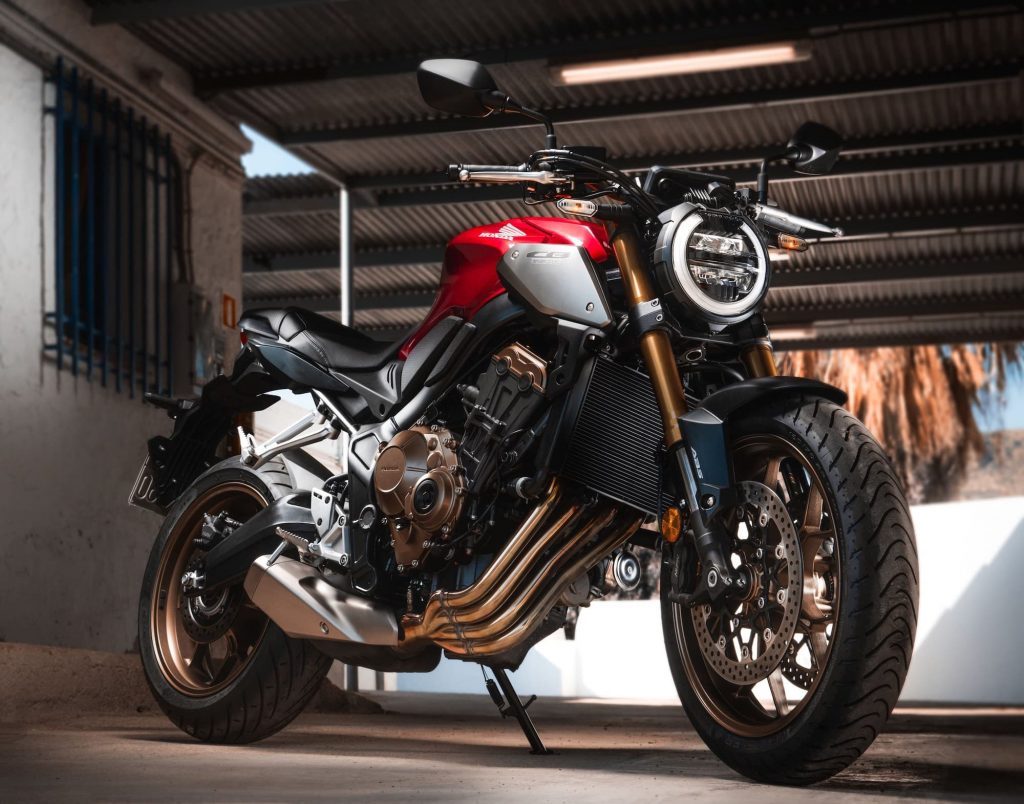
The Honda CB650R was introduced in 2019 to replace the Honda CB650F, made from 2014-2018. The CB650R is a “Neo Sports” type motorcycle, which means a naked bike that has a few retro touches like a round front headlight. But there are more than cosmetic changes — the engine was also overhauled for more power.
The CB650R is the naked sibling to the Honda CBR650R, the more “everyday sports bike” with a balanced torque curve compared to its stablemate the CBR600RR.
Since the RR is no longer produced in a reasonably-priced road-going spec (the only one available is priced similarly to superbikes), the CB650R / CBR650R are the much more practical choices for everyday riders who aren’t focused on the track.
The heart of the Honda CB650R is its 649-cc liquid-cooled inline-four-cylinder engine. It’s a classic Japanese sport-bike engine with a moderately high redline of 12 800 rpm — which means it still likes to be revved, but it’s a far cry from the redlines of 14 000 or even 16 000 rpm of other four-cylinder sport bikes.
The CB650R makes peak power of 70 kW (94 bhp / 95 PS) at 12 000 rpm, and peak torque of 63 Nm (46 ft-lb) at 9 500 rpm. There’s also a learn-legal version for A2 riders in the UK and LAMS riders in Australia/NZ, whose power difference comes via some simple changes (which a savvy dealer knows how to work around).
Even though the engine in the CB650R is a high-revving four-cylinder motor, it’s tuned for mid-range torque. There’s a lot of it in the range of 5-8000 rpm, unlike in sportier siblings like the CBR600RR supersport, which really comes on song at 8000 rpm. So the Honda CB650R is fun to use in everyday riding.
This bike comes with the Honda Selectable Torque Control (HSTC), Honda’s name for traction control, which controls the engine’s torque output by detecting differences in the slip ratio between front and rear wheels.
As for safety and security features, the CB650R has ABS, LED lights, and the Honda Intelligent Security System (HISS).
In 2021, Honda updated the CB650R. Externally, the new model got Showa Separate Function – Big Piston forks up front, though it’s still not adjustable. There’s also a USB-C port under the seat.
Internally, Honda also gave the engine an update via cam lobes, intake timing, a new exhaust/cat/silencer, and the addition of a crank pulsar.
As with the previous model, braking is via twin 310mm discs up front with 2-channel ABS, with a 240mm disc at the rear.
Manual for the Honda CB650R
The above maintenance schedule comes directly from the user’s manual for the Honda CB650R.

An archive copy of the CB650R’s manual is below.
You can also download it from Honda’s website here.

